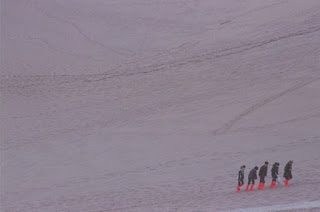(Dunhuang, China, part 2 of 3)...One of the two major tourist sites is the Mogao Caves, also knowns as the Caves of a Thousand Buddhas. (A popular name, for also I have been to the Temple of One Thousand Buddhas on Kowloon Island, Hong Kong.) The road to them lies in between the city and the airport. The drive there does not look promising, until the car rounds a low bluff. Inside the cliffs are 492 caves with a staggering wealth of Buddhist art covering more than 1,000 years.
It was deemed an UNESCO World Heritage site in 1987. The official UNESCO report that gave it such status included in its pages the following three statements:
i. “In the desert landscape of the extreme northwest of the province of Gansu are the cliffs of Magao, which form the eastern edge of Mount Mingsha. The cliffs rise above the Dachuan River, which is 25 kilometres southeast of the Dunhuang oasis. Within the cliffs are the 492 natural cells and rock sanctuaries extending over 3,000 metres that make up the famous Caves of a Thousand Buddhas (Qianfodong);
ii. The group at Mogao, so strongly linked with the history of China, also constitutes an anthology of Buddhist art with paintings and sculptures spanning a period of a thousand years;
iii. The paintings at Mogao bear exceptional witness to the civilisations of ancient China during the Sui dynasty (cave no. 302 contains one of the oldest and most vivid renderings of the Silk Route theme; the mural depicts a camel pulling a cart), the Tang dynsasty (workers in the field in acve no. 23 and a line of warriors in cave no. 156) and the Song dynasty (the celebrated landscape of Wutaishan in cave no. 61 is an incredible example of cartography, with its cavalier view of the region, where nothing has been left out—mountains, rivers, cities, temples, roads and caravans are all depicted).”
Monks worked in near darkness painting intricate scenes of both Buddha’s life anf their own, and the detail is stunning (photos of the buddhas and artifacts are not allowed, with visitors needing to deposit cameras at the entrance booth). Only about a dozen caves are open to tourists due to conservation efforts. (As there are not allowed cameras, to see some of what I describe, visit the wonderfully colourful website of the Friends of Dunhunag.)
It is incredible to conceive of these solitary monks, who started work here before Buddhism was granted religious status in China, painting while sitting on crudely constructed scaffolding inside each cave with only the light from oil-smeared wicks to work by. Some caves are small, others large.
What is most celebrated here are the gigantic buddhas. It has both the largest indoor standing Buddha and the largest indoor reclining Buddha (both are approximately 35 metres in length). In order to protect the paintings, the rooms are feebly lit, and the semi-darkness gives to the buddhas a hulking presence.
Buddhist monks lived here until 1930, although it was a Taoist (Daoist) monk—his name was Wang Yuan-lu, and there is a small exhibition about him at Mogao—who in 1900 discovered the caves’ most precious treasure, the Diamond Sutras, perhaps the world’s earliest printed document.
The world’s archaeologists and adventurers made a beeline for the place, and through one-sided deals and blatant thievery, much of the caves’ contents now can be seen in European cities.
British archaeologist Sir Marc Aurel Stein, who died in and is buried in Kabul, Afghanistan, comes under particular admonishment from Mogao’s exhibition literature, and Wang himself was to subject to much ire, too, for the ease in which he handed over cartloads of precious objects to foreigners.
Dunhuang’s other great attraction is its gigantic Mingsha sand dunes, approximately five miles west of the center of the city. A good hotel is here is the Silk Road Dunhuang Hotel. The map of Dunhuang on its website is the best map I could find, but it is pathetic.
For good or for bad, visitors are free to clamber over any dune they want at Mingsha, except for the one that stops a small lake called the Lake of the Crescent Moon (for its shape; known as “Yueyaquan” in the local dialect) from getting silted up. Long lines of clamberers snake up the dunes’ ridges, and the Westerners present refuse to wear the plastic red garters handed out to protect one's footweat from the sands. It is a little comical to see a row of seven or eight people all wearing these garters as they slowly scale a peak.
After 10 minutes or so of vigorous exercise it is possible to be all on your own.
Supposedly, when the wind blows gently the dunes sing. If the wind blows a little more steadily, it is probably advisable to get back down into Dunhuang, although even just outside of town roads can soon become impassable.
That the dunes sing is what the tourism officials told me, but when I was there all I heard was the whopping of Europeans sliding down the dunes on plastic sleds.
It is a wonderful place.
The correct name for the dunes is Mingsha Shan, translated into English as “Echoing Sand Mountain,” so who am I to doubts its tonal attributes?
Camels and, less environmentally sound, motorbikes help some to the tops of the dunes
I was told the lake has not silted up for 1,000 years, something locals seemed very proud of (there, there’s that number again, 1,000. I assume they mean in historical memory, but 1,000 just sounds so much more impressive).
Beside the lake are small fishponds and crop fields, and more camels.


No comments:
Post a Comment